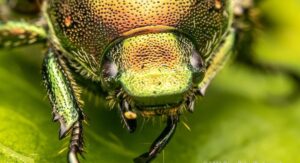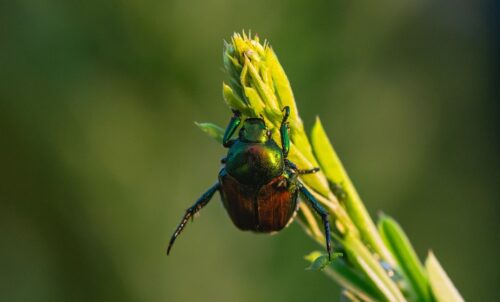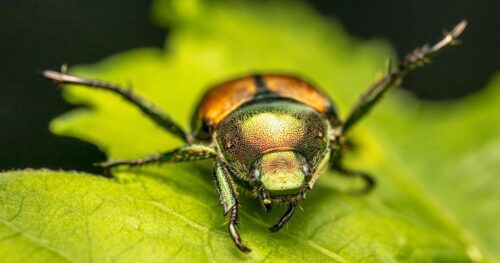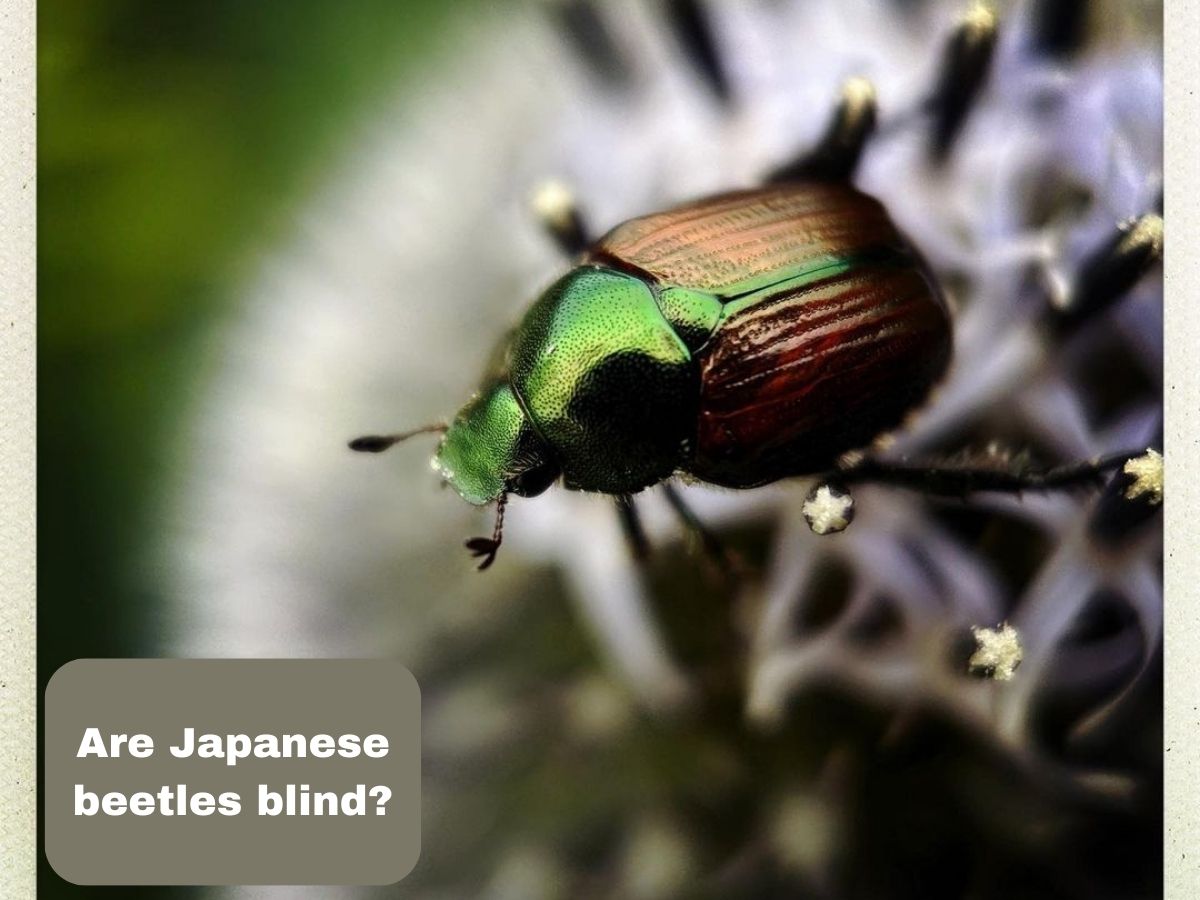Are Japanese beetles blind? Let’s tackle this intriguing question and dispel the myth surrounding these colorful critters. As gardeners and nature enthusiasts, we’ve all encountered these metallic-green beetles with their distinctive coppery-brown wings. They are fascinating creatures that can both captivate and frustrate us with their voracious appetites for our cherished plants.
Now, you might have heard people say that Japanese beetles are blind, but let me set the record straight right from the start – that’s not true. These tiny insects are far from visually impaired. In fact, they possess a remarkable visual system that allows them to navigate their surroundings with impressive precision.
In this article, we’ll dive into the world of Japanese beetles and explore the wonders of their compound eyes. We’ll uncover the truth behind their visual capabilities, understand how they find food and mates, and discover the factors that influence their behavior. So, if you’re ready to unravel the mystery of whether Japanese beetles are blind, let’s get started on this entomological adventure.
Understanding Japanese Beetles
Japanese beetles (Popillia japonica) are eye-catching insects that measure about half an inch in length. Their distinctive appearance makes them stand out in any garden or landscape. These pests have vibrant, metallic-green bodies with coppery-brown wing covers, giving them a unique and beautiful sheen.
The physical characteristics of Japanese beetles include a robust thorax and abdomen, and six spiky legs that allow them to move swiftly through plants and foliage. Their colors serve as a warning sign to predators, indicating their unpalatability due to toxic compounds accumulated from their diet.
Native to Japan, as their name suggests, Japanese beetles were accidentally introduced to the United States in the early 1900s through imported soil. Since then, they have spread across various regions of North America, becoming a major concern for gardeners and farmers alike.

Regarding habitat and distribution, Japanese beetles thrive in a variety of environments, but they particularly favor well-watered and sunny areas. Adult beetles emerge from the soil in early summer and feed on over 300 plant species, ranging from flowers and ornamental plants to fruit trees and vegetable crops.
Their distribution covers a wide range of states, primarily in the eastern and midwestern regions of the United States. They tend to be more prevalent in states such as Illinois, Indiana, Ohio, Pennsylvania, and Virginia, among others.
Common areas of infestation include home gardens, golf courses, orchards, and agricultural fields. Japanese beetles are known for their voracious appetites and their ability to swarm in large numbers, causing significant damage to foliage and fruit, often defoliating entire plants if left unchecked.
As a result, gardeners and farmers in these regions must remain vigilant and implement effective pest management strategies to protect their valuable plants and crops from the relentless feeding habits of these flashy beetles.
The Eyes of Japanese Beetles
Let’s take a closer look at the mesmerizing world of Japanese beetle eyes. Like most insects, Japanese beetles possess compound eyes, a remarkable visual system that differs significantly from the single-lens eyes we humans have.
Compound eyes are a fascinating adaptation found in many insects, providing them with a panoramic view of their surroundings. Rather than having just one lens, these compound eyes consist of thousands of individual lenses, known as ommatidia. Each ommatidium acts as a separate visual unit, capturing a tiny portion of the overall scene.
The unique structure of compound eyes enables Japanese beetles to detect light and movement with remarkable precision. This 360-degree field of vision allows them to spot potential threats or food sources from all angles, without needing to turn their heads. Imagine having eyes on the sides of your head, giving you the ability to see everything around you at once – that’s how compound eyes function for Japanese beetles.
The sheer number of ommatidia in a Japanese beetle’s compound eyes contributes to their exceptional visual acuity. The more ommatidia they have, the higher their resolution and sensitivity to light and motion. This adaptation is invaluable for survival, helping them quickly identify food, detect predators, and find potential mates.
The benefits of compound eyes extend beyond basic vision. They also aid in detecting polarized light, which assists Japanese beetles in navigating their environment and even identifying certain plants.
These extraordinary eyes are a key factor in their evolutionary success, making them formidable survivors in the world of insects. As you observe a Japanese beetle gracefully navigating through your garden, take a moment to marvel at its magnificent compound eyes, the key to its vibrant existence.

Are Japanese Beetles Blind?
Let’s put this myth to rest once and for all – Japanese beetles are not blind. In fact, these little green and bronze beauties possess an impressive visual system that allows them to perceive their world with surprising clarity.
Research conducted by entomologists and scientists has provided ample evidence to support this claim. Japanese beetles have compound eyes, a complex visual structure composed of thousands of individual lenses called ommatidia. This sophisticated design allows them to have excellent vision despite their tiny size.
With their compound eyes, Japanese beetles can detect light and movement, making them incredibly aware of their surroundings. They have a 360-degree field of vision, meaning they can see in all directions without the need to turn their heads. This panoramic view gives them a significant advantage in identifying potential threats or sources of food, which is crucial for their survival.
The ability to detect movement is particularly important for Japanese beetles. It allows them to quickly react to changes in their environment, such as the approach of a predator or the motion of a potential mate. This keen sense of sight also helps them locate ripe fruit, tender foliage, and flowers – all of which make for delectable meals in your garden.
Furthermore, Japanese beetles are capable of perceiving different levels of light intensity. This sensitivity to light helps them adjust their activity levels, with sunny days prompting increased movement and feeding, while they may be less active during cloudy or cooler weather.
So, rest assured that Japanese beetles are far from blind. With their impressive compound eyes, they navigate their world with a keen sense of awareness, making them a formidable presence in your garden. While their visual prowess is awe-inspiring, their voracious appetite may present a challenge for gardeners and farmers alike. Understanding their behavior and implementing effective pest management strategies is key to maintaining the beauty of your plants and crops while coexisting with these visually adept insects.
How far can Japanese beetles see?
Japanese beetles, with their compound eyes, have an impressive field of vision that allows them to see in multiple directions simultaneously. They can detect movement and spot potential food sources from a distance. The exact range of their vision is not precisely documented, but it’s estimated to be several feet in all directions.
The compound eyes of Japanese beetles consist of thousands of individual lenses, known as ommatidia, which provide them with a mosaic-like view of their environment. This unique design allows them to have a 360-degree field of vision, enabling them to be highly aware of their surroundings without needing to turn their heads.
With such wide-angle vision, Japanese beetles are well-equipped to spot threats, locate mates, and find food sources efficiently. This visual acuity is a crucial adaptation that aids in their survival and makes them formidable foragers in the insect world.
Do Japanese beetles rely solely on their vision to find food?
While Japanese beetles have impressive visual capabilities, they do not rely solely on their vision to find food. Instead, they use a combination of senses to locate their preferred food sources.
Japanese beetles are primarily guided by their sense of smell and their keen olfactory receptors, which are located on their antennae. These receptors allow them to detect the volatile organic compounds released by plants, helping them identify their favorite food sources from a distance.
Once they’ve honed in on a potential food plant using their sense of smell, their exceptional vision comes into play. With their compound eyes, Japanese beetles can spot movement and distinguish colors, making it easier for them to pinpoint specific parts of plants with tender foliage or ripe fruits.
So, in summary, Japanese beetles rely on both their sense of smell and their visual acuity to locate food. Their olfactory receptors help them detect the presence of suitable plants, while their compound eyes enable them to zero in on the exact location of these delectable resources.
This combined sensory approach makes them highly efficient foragers and successful pests when it comes to finding and devouring their favorite plants.

The Senses of Japanese Beetles
Insects, like Japanese beetles, rely on a variety of senses to interact with their environment effectively. Just like us, they use touch, taste, smell, sight, and even hearing to navigate the world around them.
- Touch: Insects possess sensory hairs and bristles on their bodies, primarily on their antennae, legs, and mouthparts. These sensitive structures help them gather information about their immediate surroundings, detect obstacles, and assess the texture of surfaces.
- Taste: The taste receptors of insects are located in their mouthparts, allowing them to evaluate the flavor and chemical composition of potential food sources. This helps them differentiate between palatable and unpalatable plants and find the nutrients they need.
- Smell: Insects have a remarkable olfactory system. Their antennae, in particular, play a crucial role in detecting chemical signals in the air. They can perceive pheromones released by potential mates or scent cues from plants, guiding them toward food or companionship.
- Sight: As we discussed earlier, insects like Japanese beetles have compound eyes, composed of thousands of lenses. These eyes provide them with a mosaic-like view of their surroundings, allowing them to detect movement and light in a 360-degree field of vision.
- Hearing: While insects lack ears, they can perceive sounds through specialized organs called tympanal organs. These thin membranes vibrate in response to sound waves, enabling them to detect vibrations and communicate with others of their species.
Now, let’s focus on how Japanese beetles utilize their antennae and olfactory receptors to locate food and mates:
- Antennae: Japanese beetles’ antennae are not just for show; they are instrumental in their quest for sustenance and companionship. The antennae are covered in tiny sensory hairs, allowing them to pick up chemical cues from their surroundings. When searching for food, they can detect the volatile organic compounds released by plants. This ability helps them locate their favorite delicacies, such as roses, grapes, and other preferred plant species.
- Olfactory Receptors: The olfactory receptors located on the Japanese beetles’ antennae are especially sensitive to pheromones. These chemical signals are released by females to attract males during mating season. When a male detects these pheromones, he uses his keen vision to follow the scent trail, leading him to a potential mate.
Japanese beetles are well-equipped with antennae and olfactory receptors that enable them to find food and mates efficiently. Their sophisticated sensory system helps them navigate their environment, detect attractive scents, and interact with others of their species, making them formidable survivors and successful reproducers in the insect world.
Do Japanese beetles prefer light or darkness for their activities?
Japanese beetles are diurnal insects, meaning they are most active during the day and prefer light for their activities. They are especially active on warm and sunny days when natural light is abundant. Bright sunlight stimulates their feeding and mating behaviors, and they tend to be more active during these periods.
During the day, Japanese beetles are highly visible and can be seen swarming around plants, feeding on leaves and flowers, and engaging in mating rituals. Their compound eyes, with thousands of lenses, provide them with excellent vision, which is particularly useful during daylight hours when their surroundings are well-lit.
In contrast, Japanese beetles are generally less active during the night and prefer darkness for resting and seeking shelter. As the sun sets and light levels decrease, they tend to settle down, finding hiding spots in the foliage or seeking shelter in shaded areas.
The preference for daytime activity is a common trait among many insects, as daylight offers better visibility and a more abundant food supply.
Being diurnal insects, Japanese beetles have evolved to take advantage of the ample opportunities provided by the light of day to forage for food, locate mates, and fulfill other essential activities for their survival and reproduction.
Factors Affecting Japanese Beetle Behavior
Environmental factors play a significant role in shaping the behavior of Japanese beetles, including their visual abilities. Weather conditions and light intensity are among the key factors that can influence their behavior and activity levels.
Weather Conditions:
Japanese beetles are highly responsive to changes in weather. Warm and sunny days are known to increase their activity levels. During sunny weather, they become more active in search of food and potential mates. The warm temperatures also accelerate their metabolic rate, making them more voracious eaters during these periods.
Conversely, cooler temperatures, especially in the early morning or late evening, tend to reduce their activity. They may be less active and less likely to feed during these times. Additionally, Japanese beetles are known to take refuge from extreme heat, seeking shelter in shaded areas to avoid dehydration.
Light Intensity:
Light plays a critical role in regulating the behavior of Japanese beetles. These insects are diurnal, meaning they are most active during the day when natural light is abundant. Their compound eyes are finely tuned to detect even subtle changes in light intensity.
Bright sunlight stimulates their feeding and mating behaviors. It enhances their visual acuity, making it easier for them to find and consume food. The increased light intensity also aids male beetles in detecting the pheromones released by females, helping them locate potential mates.
On the other hand, during cloudy or overcast days, Japanese beetles may exhibit reduced activity. The lower light levels may make them more cautious, affecting their feeding and mating behaviors. Furthermore, they may seek shelter during such conditions to avoid potential predators.
Understanding these environmental factors and their impact on Japanese beetle behavior is crucial for gardeners and farmers seeking to manage their populations effectively.
By monitoring weather conditions and light intensity, it becomes possible to predict when these beetles are most active and take appropriate measures to protect crops and ornamental plants from their feeding frenzy.
Implementing pest management strategies during peak activity periods can significantly reduce the damage caused by Japanese beetles and preserve the beauty of your garden.
Japanese Beetle Feeding Habits
Japanese beetles are notorious for their insatiable appetite, and their diet preferences encompass a wide range of plant species. These voracious feeders are particularly attracted to plants with soft, tender foliage and sweet, juicy fruits. Some of their favorite delicacies include roses, grapes, raspberries, linden trees, and various ornamental plants.
Their feeding behavior is both destructive and distinctive. Adult Japanese beetles emerge in early summer and immediately embark on a feeding frenzy. They typically feed in groups, which can lead to severe defoliation if left unchecked. Large swarms of Japanese beetles can strip entire leaves off plants, leaving behind only skeletal remains.
Their feeding behavior is guided by a combination of their keen sense of smell and impressive visual capabilities. As they fly through the air, their antennae pick up on the volatile organic compounds released by plants. This olfactory sense helps them detect their preferred food sources from a distance.
However, it’s their vision that truly sets them apart as foragers. With their compound eyes, Japanese beetles have a wide-angle view of their surroundings, enabling them to spot potential food sources with remarkable precision. Their eyes are sensitive to movement, allowing them to detect even the slightest twitch of leaves or petals.
Once they’ve located a promising food source, they quickly descend upon it, devouring leaves and fruits with gusto. Their ability to see in multiple directions simultaneously gives them a competitive edge, making them highly efficient in finding food and ensuring their survival.
The combination of their olfactory and visual senses makes Japanese beetles formidable adversaries for gardeners and farmers. To protect their crops and ornamental plants, individuals must implement a comprehensive pest management strategy that includes measures to deter and control these voracious feeders.
By understanding the role of vision in their feeding behavior, gardeners can take timely action to defend against Japanese beetle invasions and preserve the health and beauty of their green spaces.

Pest Management Strategies
Managing Japanese beetle infestations requires a multi-faceted approach that combines both organic and chemical methods. Here are some effective strategies to control their population:
- Handpicking: For small-scale infestations, physically removing Japanese beetles from plants by hand can be an efficient method. Wear gloves and place a bucket of soapy water beneath the plants. Shake the beetles off the plants, and they will fall into the soapy water, where they will drown.
- Row Covers: Protective row covers made of fine mesh can be used to physically block adult beetles from reaching plants. These covers are particularly useful for shielding valuable crops and ornamental plants during peak beetle activity.
- Neem Oil: Neem oil is an organic insecticide derived from the neem tree. It acts as a repellent and disrupts the feeding and mating behaviors of Japanese beetles. Spray neem oil on plants to deter these pests and protect your greenery.
- Milky Spore Disease: Milky spore disease is a biological control method specific to the larvae of Japanese beetles. This naturally occurring bacterium (Bacillus popilliae) infects and kills the beetle larvae in the soil, reducing their population over time. It is safe for other beneficial insects and does not harm the environment.
- Beneficial Nematodes: Nematodes are microscopic roundworms that can be applied to the soil to target Japanese beetle larvae. These nematodes enter the larvae and release bacteria that cause fatal infections, thus reducing the number of emerging adults.
- Insecticidal Soap: Insecticidal soap is another organic option to control Japanese beetles. It works by suffocating the pests upon contact. Regular application can help deter and manage their population.
- Pyrethrin-Based Insecticides: For more severe infestations, pyrethrin-based insecticides can be effective against adult Japanese beetles. Pyrethrin is derived from chrysanthemum flowers and provides a quick knockdown of the beetles. However, use caution as these insecticides can also harm beneficial insects.
- Traps: Japanese beetle traps are available commercially and can be useful for capturing adult beetles. However, they should be used with caution as they may attract more beetles to your garden if not placed correctly.
When applying any chemical method, it’s essential to follow the instructions on the product label carefully to ensure safe and effective use. Additionally, consider using a combination of strategies to create a holistic and sustainable pest management plan.
By taking proactive measures and being consistent in your efforts, you can mitigate Japanese beetle damage and maintain the health and beauty of your garden or crops.
Are Japanese Beetles Blind FAQs?
Can Japanese beetles see colors?
Yes, Japanese beetles can see colors. Their compound eyes, with thousands of individual lenses (ommatidia), provide them with the ability to perceive different wavelengths of light, including colors.
While their color vision might not be as detailed as that of humans, they can distinguish between various colors. This visual acuity is essential for identifying food sources, and potential mates, and differentiating between objects in their environment.
What are some natural predators of Japanese beetles?
Several natural predators help control Japanese beetle populations in the ecosystem. Some of the common predators include:
- Birds: Starlings, sparrows, crows, and grackles are known to prey on adult Japanese beetles.
- Insects: Predatory insects like ground beetles, soldier beetles, and certain wasp species feed on Japanese beetle eggs, larvae, and adults.
- Mammals: Moles and shrews may consume Japanese beetle grubs found in the soil.
Are there any specific plants that attract Japanese beetles more than others?
Japanese beetles have distinct plant preferences and are particularly attracted to certain species. Some of the plants that are more likely to attract Japanese beetles include:
- Roses (both hybrid and wild varieties)
- Grapes
- Raspberries and blackberries
- Linden trees (basswood)
- Birch trees
- Crepe myrtle
- Virginia creeper
- Purple loosestrife
These plants, among others, emit volatile organic compounds that Japanese beetles can detect with their olfactory receptors, drawing them to these specific food sources.
Are Japanese beetles harmful to humans?
Japanese beetles are not harmful to humans in the sense that they do not bite, sting, or transmit diseases. However, they can be a significant nuisance to gardeners and farmers.
Their voracious feeding habits can cause extensive damage to a wide range of plants, leading to defoliation and reduced crop yields. Additionally, the presence of large numbers of Japanese beetles can be unsightly and disruptive to the aesthetics of gardens and landscapes.
While Japanese beetles do not pose direct health risks to humans, their impact on agriculture and horticulture can have economic consequences. Consequently, managing their populations and minimizing their damage is essential for maintaining the health and productivity of plants and crops in affected areas.
Conclusion
In conclusion, the fascinating world of Japanese beetles unveils a story of resilience, adaptability, and efficient survival strategies. Despite the persistent myth, we have established with confidence that Japanese beetles are not blind.
Their compound eyes, composed of thousands of lenses, grant them an impressive 360-degree field of vision, allowing them to detect movement, spot potential food sources, and locate mates with remarkable precision.
As they emerge in the warmth of summer, Japanese beetles embark on a feeding frenzy, targeting a diverse range of plants with soft foliage and sweet fruits.
Their keen sense of smell, combined with their exceptional vision, guides them toward delectable sustenance and potential companionship. While these attributes make them formidable foragers, their voracious appetite can pose challenges for gardeners and farmers.
However, by understanding their behavior and employing a combination of pest management strategies, including handpicking, row covers, natural predators, and organic insecticides, we can effectively control their populations and protect our cherished green spaces.
In the dynamic dance of nature, Japanese beetles play a vital role, connecting with the environment through their senses and influencing the ecosystems they inhabit. As we coexist with these vibrant insects, let us foster harmony and balance, ensuring the health and beauty of our gardens and crops while appreciating the marvels of their visually adept existence.
